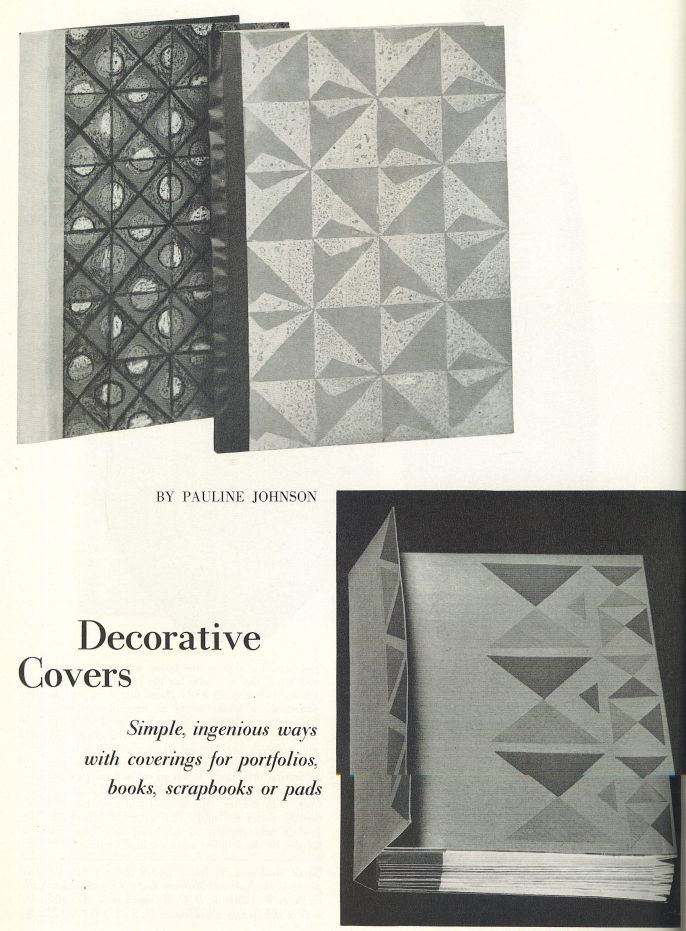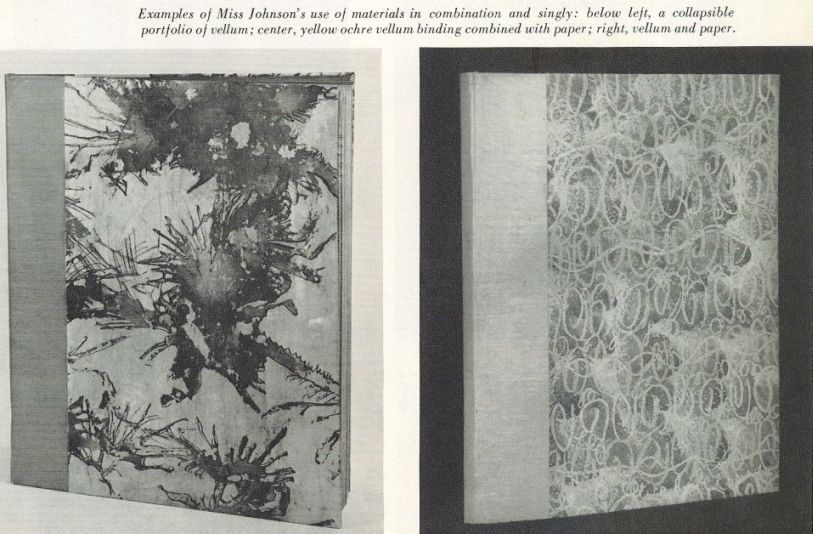Decorative Covers

DESIGNING bindings and endpapers may become an exciting adventure if it is approached in a free, experimental manner. The creative possibilities are infinite, using simple materials, with fresh applications and in new combinations of paper, cloth, vellum or leather.
First of all, take paper. A roll of butcher paper is an excellent medium to start experiments with. Thinking in terms of paper design, one should practise many processes and try to exhaust the potentialities of each. Crayola and paint offer a variety of decorative effects. The crayon may be applied in controlled geometric shapes or in very free, flowing lines and areas, with a wash of water color or tempera brushed over to cover the bare spots. Crayon can also be used as scratch-resist, where a dark color is applied over a lighter one and the design scratched through with a knife, brush handle, scissors or other hard edge. This gives a print-like quality.
Another method for decorating papers is to use hot wax (about equal parts of beeswax and paraffin). The wax is cut up, melted in a pan and applied with a brush, then paint is brushed over the entire surface. This is similar to using crayola but less controlled, freer. It gives a batik effect. The wax may be pressed out later with a warm iron if desired. For variation, the paper may be crushed in the hands and then opened out to reveal interesting crinkle lines. Crushing the paper in a pan of water, then dipping it in a pan of dye, or in two different dye baths, also produces an intriguing line pattern.

One of the most stimulating approaches to paper design is potato printing a method of stamping. The common potato offers interesting possibilities. Simply by cutting it in half, applying poster or water color paint with a brush, a shape can be stamped on paper and repeated. This can be varied, and still retain its original form, by breaking up the surface of the potato by jabbing, cutting or scratching it, then using it as a stamp again. The repeat can be regular and orderly or very freely printed with some areas overlapping others. Lines, dots and various other shapes can even be painted and then stamped. Or the potato may be cut in controlled, simple shapes such as triangles and squares, often very effective. Carrots and parsnips afford further variations as printing mediums— the texture alone of the parsnip, when cut open and used for printing, produces a lovely grain-like pattern.

Taking up one method at a time is best. However, before long the designer will find himself combining methods; for instance, using wax, crayon and potato printing together; or melting crayon scraps in hot beeswax and paraffin. It is inspiring, from time to time, to look at the hand-printed papers of the Japanese, the Italians, the English and others.
Materials also eminently well suited to book covers are cloth, vellum and leather. Cloth should be considered for its texture as well as its color. Denim, sailcloth and canvas (as well as many others) are excellent for this purpose. Cloth can be decorated; it can also be combined with vellum effectively. Vellum as a book covering stands complete in itself, or may be combined with other materials. It comes in many colors ranging from brilliant hues to subtle greved tones and off-white. One bookbinding supply house furnishes it in one-yard lengths at very reasonable prices. Paint or India ink can be applied directly on vellum. Or the material can be cut like paper and used for applique in a variety of shapes. It lends itself to design areas rather than detailed lines; it is important to think in terms of contrasts and color values.
Running a brayer of printer’s ink over pieces of wire mesh, leaves and other objects affords most unusual printed effects. Art gum erasers, linoleum scraps, pieces of discarded inner tubes—countless everyday objects— offer a challenge to experiment; it is not the abundance of material but the creative ingenuity that counts. All of these methods allow for individual freedom and tend to release rather than restrict the inventive powers.
Finger painting can also be effective. This calls for experimentation for pleasing results in line, texture and color. The base for this paint can be made of hot water thickened with cornstarch, with soap flakes added; or powdered wheat or wallpaper paste and water stirred up together ; or ready-prepared laundry starch. To all of these, just add a little powder paint or tempera. Here again, butcher paper is a good material to work on. There are many other methods including the familiar one of using oil paint on water and laving the paper on it to absorb the irregular color swirls. Running brushes full of paint over paper, either wet or dry, can also be effective. Dropping puddles of paint on the paper and then blowing on it, or tipping it, gives interesting results.
After working with paper and vellum, leather seems new and exciting. It has a feeling of stability and permanence, yet can be treated in a most flexible manner. It may be dyed or stained; experimenting on scraps, the designer can develop many beautiful colors. Leather can be tooled, stamped, cut or combined with other leathers. Sometimes the texture is pleasing in itself, without decoration. -Unusual skins such as ostrich, reptile and Norwegian sea leopard are especially effective.
It is well to begin with simple projects such as the small pencil pad, portfolio or scrapbook and other similar items. These afford an opportunity to learn how to cut boards that are squared, to mitre corners, to paste carefully and to apply lining papers with even edges. These problems should be treated individually, as complete studies, with the object of using materials always to the best possible advantage.
Illustrations for this article by Miss Pauline Johnson, Associate Professor of Art, University of Washington, Seattle, were culled from the work done by her students.

